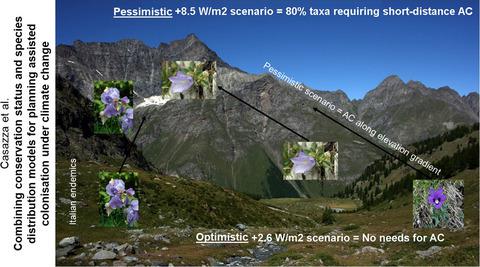Our official English website, www.x-mol.net, welcomes your
feedback! (Note: you will need to create a separate account there.)
Combining conservation status and species distribution models for planning assisted colonisation under climate change
Journal of Ecology ( IF 5.3 ) Pub Date : 2021-01-28 , DOI: 10.1111/1365-2745.13606 Gabriele Casazza 1 , Thomas Abeli 2 , Gianluigi Bacchetta 3 , Davide Dagnino 1 , Giuseppe Fenu 4 , Domenico Gargano 5 , Luigi Minuto 1 , Chiara Montagnani 6 , Simone Orsenigo 7 , Lorenzo Peruzzi 8 , Lucia Varaldo 1 , Graziano Rossi 7
中文翻译:

结合保护状况和物种分布模型以规划气候变化下的辅助殖民
更新日期:2021-01-28
Journal of Ecology ( IF 5.3 ) Pub Date : 2021-01-28 , DOI: 10.1111/1365-2745.13606 Gabriele Casazza 1 , Thomas Abeli 2 , Gianluigi Bacchetta 3 , Davide Dagnino 1 , Giuseppe Fenu 4 , Domenico Gargano 5 , Luigi Minuto 1 , Chiara Montagnani 6 , Simone Orsenigo 7 , Lorenzo Peruzzi 8 , Lucia Varaldo 1 , Graziano Rossi 7
Affiliation

|
- Effects of climate change are particularly important in the Mediterranean Biodiversity hotspot where rising temperatures and drought are negatively affecting several plant taxa, including endemic species. Assisted colonisation (AC) represents a useful tool for reducing the effect of climate change on endemic plant species threatened by climate change.
- We combined species distribution models (SDMs) for 188 taxa endemic to Italy with the IUCN red listing range loss threshold under criterion A (30%) to define: (a) the number of AC (measured as 2 × 2 km grid cells that should be occupied by new populations, i.e. grid cells = new populations) required to fully compensate for predicted range loss and to halt the decline below the 30% of range loss; (b) The number of cells necessary to compensate for range loss was calculated as the number of currently occupied cells lost under future climate due to unsuitable conditions. We used two representative concentration pathways, +2.6 and +8.5 W/m2, optimistic and pessimistic scenarios respectively. Availability of suitable areas for AC was also assessed within the current species distribution and within protected areas.
- Under the optimistic scenario, no taxa would lose more than 30% of their range and AC would not be required. Under the pessimistic scenario, roughly the 90% of taxa showed a cell loss higher than 30%. Eight taxa were predicted to lose >95% of their range. For these species, AC was required from 13 to 16 new populations (=13–16 grid cells) per taxon to cap the range loss at 30%. For currently VU or EN species, an average number of 32–35 AC attempts would be necessary to fully compensate their range loss under a pessimistic scenario. Suitable recipient sites within protected areas falling in their projected range were identified, allowing for short-distance AC.
- Synthesis. Combining species distribution models and red listing thresholds under Criterion A has enabled the strategic planning of multiple species assisted colonisation minimising the effort in terms of new populations to be created and maximising the conservation benefit in terms of range loss compensation.
中文翻译:

结合保护状况和物种分布模型以规划气候变化下的辅助殖民
- 气候变化的影响在地中海生物多样性热点地区尤为重要,在那里气温升高和干旱对包括地方物种在内的几种植物类群产生负面影响。辅助定植 (AC) 是一种有用的工具,可用于减少气候变化对受气候变化威胁的地方性植物物种的影响。
- 我们将意大利特有的 188 个分类群的物种分布模型 (SDM) 与标准 A (30%) 下的 IUCN 红色名录范围损失阈值相结合来定义:(a) AC 的数量(测量为 2 × 2 km 网格单元,应该被新种群占据,即网格单元 = 新种群)需要完全补偿预测的距离损失并停止下降到距离损失的 30% 以下;(b) 补偿距离损失所需的单元格数量计算为由于不合适的条件在未来气候下丢失的当前占用单元格的数量。我们分别使用了两个有代表性的浓度路径,+2.6 和 +8.5 W/m 2,分别是乐观和悲观情景。还在当前物种分布和保护区内评估了适合 AC 的区域的可用性。
- 在乐观的情况下,没有一个分类群会失去超过 30% 的范围,并且不需要 AC。在悲观的情况下,大约 90% 的分类群显示出高于 30% 的细胞损失。预计八个分类群将失去其范围的 95% 以上。对于这些物种,每个分类群需要 13 到 16 个新种群(=13-16 个网格单元)才能将范围损失限制在 30%。对于目前的 VU 或 EN 物种,在悲观情景下,平均需要 32-35 次 AC 尝试才能完全补偿它们的距离损失。确定了保护区内落在其投影范围内的合适接收点,允许短距离交流。
- 合成。将标准 A 下的物种分布模型和红色名录阈值相结合,可以实现多物种辅助殖民的战略规划,最大限度地减少新种群的创建工作,并在范围损失补偿方面最大限度地提高保护效益。











































 京公网安备 11010802027423号
京公网安备 11010802027423号